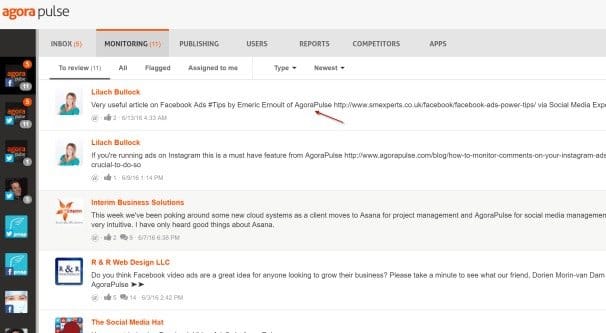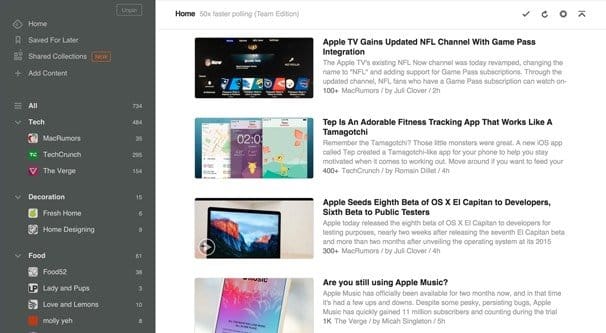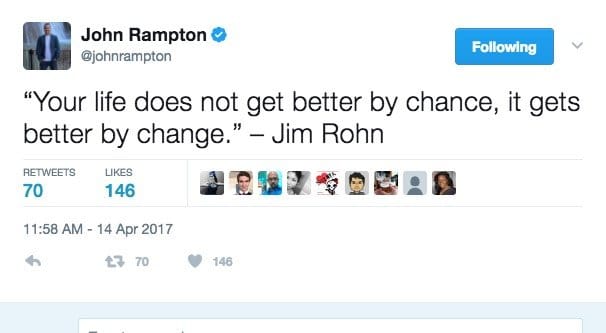 Written by ContentPowered.com
Written by ContentPowered.com
One of the secrets of Facebook marketing is that surprisingly little of what you post is actually your own content. Facebook works best if you come across as if you’re sharing content your audience likes, as if it’s an extended friend circle, rather than simply advertising yourself to them. Often, you will only be sharing your own content or your own links once or twice a week, and the rest of the time you’re curating content or producing content that isn’t focused on marketing.
I assume you already know all about creating your own excellent content, but you want more, and you want to find it from other sources. So to facilitate that, let’s talk about other places you can find good content to share.
Analyze Your Audience
Before you do anything, the first thing you need to do is get a firm grasp on your audience. Knowing who your audience is will help you determine exactly what is going to be engaging to them. You don’t want to share cutting edge fashion blog posts to an audience that doesn’t really care about clothing one way or another. You don’t want to share new car announcements to an audience that generally doesn’t drive. You don’t want to share all about an event taking place in a country the majority of your readers will never think about visiting, unless that’s the kind of thing they like.
Now, this isn’t a replacement for testing. As you share curated content from various sources and on various topics, you will need to harvest information about them.
Keep track of the reach, the engagement, the clicks, and any other salient pieces of information for each post. Eventually, you will be able to dial in on the target and start laser-focused curated content that always results in high engagement. It’s like shooting a gun; you’ll hit the target eventually, but it’s easier when you know which direction to face first.
Read Facebook Comments
The first place you should check to find content to share on your Facebook page is, well, your Facebook page. Specifically, look at your wall and your posts. Your users will often be commenting or posting on your wall, and they’ll have items of interest they bring up. Some of them will have questions or concerns. Some of them want to know how you’re going to react to some relevant current event. Some of them will be providing their own content. All of this can lead to some inspiration.
For example, in order:
- You can address public concerns about your product or your company in a post.
- You can share a well-written post about a current event along with your comment explaining your position and thoughts.
- You can ask users who share pictures of your product, or some other relevant content, if you can use it. Then you can make “user showcase” a regular feature on your page and get even more engagement out of the people looking to share.
In every case, it’s user inspiration leading to content you can post. Now, this only works when you have an audience that is both engaged and capable of posting insightful or interesting content on your page. If you don’t have that, you’ll find a relatively dry well.
Monitor the Competition
Make a list of your top competitors, those brands that are most like your own, and monitor their posts. Create a test account to follow them if you have to, or even a few to look into their targeting. Just don’t use those accounts for anything nefarious, they’ll be banned as fakes if you’re not careful.
You have two options here; you can mimic them or you can stray from their plan.
If you mimic them, what you want to do is cover the same topic but from a different angle. If a new iPhone comes out and they post an article from TechCrunch about it, you can cover the iPhone but with an article from EnGadget. Same topic, different coverage, same appeal to a similar audience.
If you stray from them, what you should be doing is monitoring to see where their posts fall flat and try to fix those mistakes. If they share an article about the new iPhone, you might learn that their audience and yours both tend to lean more towards Android devices, so you can instead share a post about the new Galaxy.
Alternatively, it can be in the emphasis of the content. Maybe your competitors like more tech-focused articles with specifics and details about the chips inside the phone, while your audience prefers posts you share about the kinds of app compatibility and lifestyle enhancements that come with the device. Similar topic, different perspective and emphasis.
If you’re keeping all of your marketing contained with one team – rather than having a blog team and a social team, for example – you’ll probably have created a keyword list for your industry and brand. You can search for those keywords on social media platforms in the form of hashtags. Pinterest, Instagram, and Twitter are all good sources, and Tumblr can be great for some industries, though not for everyone.
Monitor these tags to see what people in the industry are doing. Try to share something new and cutting edge every day or so. You can get a lot of mileage out of curating excellent social content very quickly. The longer you wait, the older the post is, and the more likely your audience will be to have seen it already and not engage with your copy of it.
With Pinterest, you can even set up a board to keep your research and possible ideas, as well as pinned searches, so they’re all saved in one place.
Follow the Influencers
Influencers are influential because they have large followings. Nothing stops you from being one of those followers. Finding the people who are on the cutting edge of your industry is a great way to always see the inside story, the breaking news, the new hot takes form the people who have far more information than you have. You shouldn’t just blindly parrot everything they say – and you can even share their post while disagreeing with it to spur conversation – but they’re a good source for interesting tidbits and dialogue.
This is assuming they’re the kinds of influencers who actually talk about interesting things. Often, you will find the top-tier influencers are either entirely self-promotional, post nonsense or personal stories, or just don’t post much. You might have better luck with…
Subscribe to Top Blogs and News Agencies
…The journalists. When you think about it, what you’re doing here is basically just trying to reverse-engineer journalism for yourself. To this end, it’s generally a good idea to keep an eye on the actual industry and niche journalists.
These people have connections, sources, and perspectives you don’t. Plus, they have a lot more time to put together the items they report, and you get to benefit from the fruits of their labor. Look for news, look for interesting quotes, look for statistics, and anything else that might appeal to your audience.
Monitor Industry and Brand Relevant Reddits
Sometimes it seems like Reddit has a subreddit for everything. You can often find subs for all kinds of narrow sub-niches of your industry. To take an example, there is a sub for gaming in general, one for PC gaming, one for different types of PC gaming, ones for gaming with different levels of hardware, ones for every individual game, ones for individual pieces and brands of hardware, and on and on. You can pretty easily find a few dozen different subs you want to monitor.
The trick with Reddit is that their audience is generally quite niche focused. The site as a whole is huge, but individual subs might be quite small, and what that sub likes might not actually be engaging to the majority of your audience. On the other hand, it might be a great source of curated content, so give it a try and see how it pans out with your metrics.
Adapt New and Popular Memes
We’ve covered memes before, but I’ll reiterate a few warnings here. Memes are often extremely viral, but they also pick up and drop off extremely quickly. A meme that pops up today might not be funny a week from now, and that’s not an exaggeration. The turnover rate is very quick. This means you run two risks. The first is if you try to take a meme and brand it, or make your own meme from scratch, you might end up like the notorious pen fiasco. The other risk is smaller, and is simply that you might end up using an old meme and looking out of touch to your audience. Make sure what you use is actually amusing to the people you’re posting to. Old memes can circulate later in some circles, which gives you the opportunity to use them before the audience would otherwise see them. Again, just know your audience.
Stoop to Inspirational Quote Level
I say “stoop” here because, frankly, this is kind of the lowest tier of content on Facebook. A basic inspirational quote with a basic image and some moderate typography has brought more than one Facebook page from mediocrity to millions of followers.
The thing is, they are basically substanceless posts. Inspirational quotes are nice, but they don’t really engage your audience much beyond basic “god bless” style comments. They also aren’t particularly industry-focused or branded, unless you heavily curate the quotes to make sense with your brand. A car company sharing something from Robin Williams isn’t all that connected. The same company sharing a quote from Henry Ford is a lot more relevant.
Find and Curate Great Pictures
Pinterest, Instagram, Google searches, and other image-heavy sources can get you a lot of great images you can post for engagement. However, before you share or post an image, make sure you have the appropriate permissions to do so. Sharing an image without permission is a copyright issue and can actually result in legal action. I generally recommend finding the original source and asking if you can use it for non-commercial uses – or commercial, if it’s for an ad – and getting permission. That, or sculpting the search to look for specifically creative commons images that are free to use.
Images alone don’t do much, so you need to accompany them with a comment or a link that brings out the users to engage. Asking questions relevant to the image is a good way to get them commenting, and you can learn more about them from what they have to say.
Run Contests
At the end of the day, a contest is one of the most engaging types of post on Facebook. I bring it up last for two reasons. First, because it’s not really a kind of content you find and share, it’s something you produce. Secondly, it’s not something you can just up and post as filler, it’s something that takes a lot of development, planning, and attention. You can’t just start a contest without rules, judging, selection, and a prize. You also can’t run a different contest every day.
All of these methods can be combined into a weekly and monthly cycle of content curation, wherein you find interesting content, add interesting contributions from your own perspective, and share the post with your audience. Over time, you’ll be able to zero in on what they like the most, and you can keep sharing that kind of content, to reinforce your audience and bring in more like-minded users. Higher engagement rates leads to higher reach, more conversions, more clicks, and generally more of everything. It’s an excellent place to be.






